EXPLORATION: Effects of Natural Disasters
| Site: | MoodleHUB.ca 🍁 |
| Course: | World Geography 30 |
| Book: | EXPLORATION: Effects of Natural Disasters |
| Printed by: | Guest user |
| Date: | Wednesday, 24 December 2025, 11:21 AM |
1. What is a natural disaster?
The definition of natural disasters is any catastrophic event that is caused by nature or the natural processes of the earth. The severity of a disaster is measured in lives lost, economic loss, and the ability of the population to rebuild. Events that occur in unpopulated areas are not considered disasters. So a flood on an uninhabited island would not count as a disaster, but a flood in a populated area is called a natural disaster.

All natural disasters cause loss in some way. Depending on the severity, lives can be lost in any number of disasters. Falling buildings or trees, freezing to death, being washed away, or heat stroke are just some of the deadly effects. Some disasters cause more loss of life than others, and population density affects the death count as well.
Then there is loss of property, which affects people’s living
quarters, transportation, livelihood, and means to live. Fields
saturated in salt water after tsunamis take years to grow crops again.
Homes destroyed by floods, hurricanes, cyclones, landslides and
avalanches, a volcanic eruption, or an earthquake are often beyond
repair or take a lot of time to become livable again. Personal effects,
memorabilia, vehicles, and documents also take a hit after many natural
disasters.
The natural disasters that really affect people worldwide
tend to become more intense as the years go on. Frequency of
earthquakes, megastorms, and heat waves has gone up considerably in the
last few decades. Heavy population in areas that get hit by floods,
cyclones, and hurricanes has meant that more lives are lost. In some
areas, the population has gotten somewhat prepared for the eventuality
of disasters and shelters are built for hurricanes and tornadoes.
However, loss of property is still a problem, and predicting many
natural disasters isn’t easy.
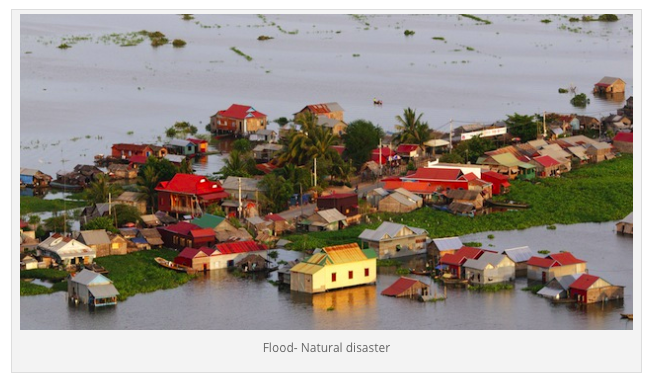
Scientists, geologists, and storm watchers work hard to predict major disasters and avert as much damage as possible. With all the technology available, it’s become easier to predict major storms, blizzards, cyclones, and other weather related natural disasters. But there are still natural disasters that come up rather unexpectedly, such as earthquakes, wildfires, landslides, or even volcanic eruptions. Sometimes, a time of warning is there, but it’s often very short with catastrophic results. Areas that are not used to disasters affected by flash floods or sudden hail storms can be affected in an extreme way.
However, despite the many natural disasters the world over, people have shown amazing resilience. When an area or country is badly affected by a natural disaster, the reaction is always one of solidarity and aid is quick to come. There are organizations set up with the primary goal of being prepared for natural disasters. These groups work on global and local scale rescue work. Aside from those who have chosen to make disaster relief their life-work, when disasters hit, it’s the individuals who step in who help to make a difference.
Many people talk about when a disaster has hit and their neighbours and other citizens have come to aid, often to their own loss. People will step in and donate items, time, and skills in order to help those affected by a natural disaster. Celebrities will often do what they can to raise money through concerts, phone marathons, and visiting affected areas with aid. People have also shown that they can rebuild, lives can be remade or start over. Trauma is a big after effect of natural disasters and getting counseling has been the focus of aid—to heal emotionally as well as physically.
It’s clear that natural disasters are a part of life as we know it. However, science is making it more possible to predict, aid is faster at coming, and people are learning how to rebuild in safer areas.
Text and photos on this page from Basic Planet - Natural Disasters
2. Effects of Earthquakes
The energy released from an earthquake can be up to 10,000 times more powerful than the first atomic bomb. Its side-effects can be:
Ground shaking
Shaking of the ground caused by the passage of seismic waves, especially surface waves near the epicentre of the earthquake are responsible for the most damage during an earthquake. The intensity of ground shaking depends on:
- conditions of the local geology influence events: solid bedrock is far less subject to intense shaking than loose sediment;
- duration and intensity of the earthquake are subject generally to the size of the earthquake;
- distance: the distance from the epicentre drops off so the intensity of the shaking decreases. This depends on the type of material underlying the area. There are however some exceptions. The 1985 Earthquake in Mexico city (magnitude 8.1) had its epicentre 350 Km away to the south on the coast. Damage to city was extensive as Mexico city is built on a former lake made up of soft Sediment. This is known as liquefaction.
Faulting and Ground Rupture
When an earthquake event occurs, ground rupture is only where the fault zone moves. Those constructions built adjacent to the fault will survive while structures built across these zones will collapse.
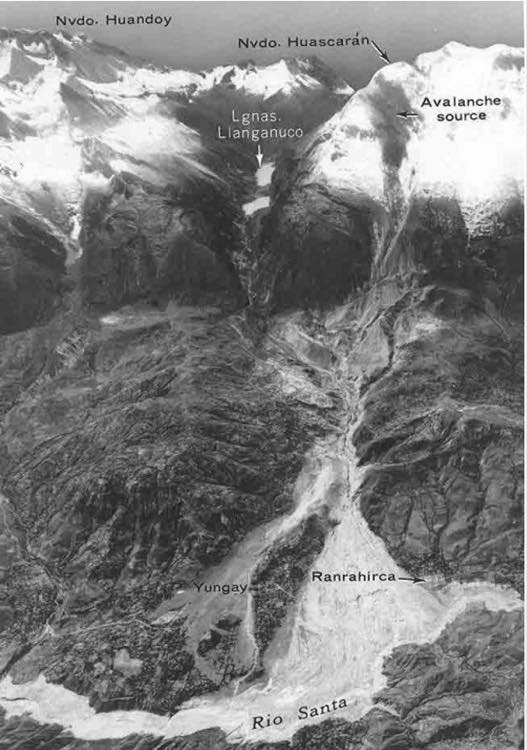 Landslides and ground subsidence
Landslides and ground subsidence
Avalanches, landslides, slumps and rock slides are triggered by ground shaking. These landslides are often more destructive than the earthquakes.
The image to the right depicts the results of the Ancash Earthquake which struck off the coast of Peru in May of 1970. Measuring 7.9 on the Richter Scale, it triggered an avalanche and rockslide which buried several towns, destroying 90% of the buildings in Huaraz, the area's capital. It is estimated to have unleashed about 80 million cubic metres of ice, mud and rocks which traveled at hundreds of kilometres per hour.
River course alteration
Earthquakes can alter the course of a river and can even cause it to flow in the opposite direction for a short time (this happened to the Mississippi River in the late 1800's). River course alteration from an earthquake can be temporary or permanent.
Tsunamis
One of the most dangerous effects of an earthquake is a tsunami. Tsunamis are giant waves that can cause floods and in some cases may reach up to 30 metres in height. These deadly waves strike a great distance from the epicentre. Tsunamis often result from sub-sea faulting of ocean floor sending seismic shocks through the water and creating large waves of low amplitude but of long period, moving at 800 to 1000 kmh.
The tsunami caused by an earthquake in the sea near Sumatra on 26th Dec, 2004 hit southeast Asian countries including Indonesia, Thailand, India and Sri Lanka. There was heavy damage in these countries. More than 300,000 people died.
Text on this page adapted from SMS Tsunami Warning
3. Human System Impact - Earthquakes
Some of the common impacts of earthquakes include structural damage to buildings, fires, damage to bridges and highways, initiation of slope failures, liquefaction, and tsunami. The types of impacts depend to a large degree on where the earthquake is located: whether it is predominantly urban or rural, densely or sparsely populated, highly developed or underdeveloped, and of course on the ability of the infrastructure to withstand shaking.
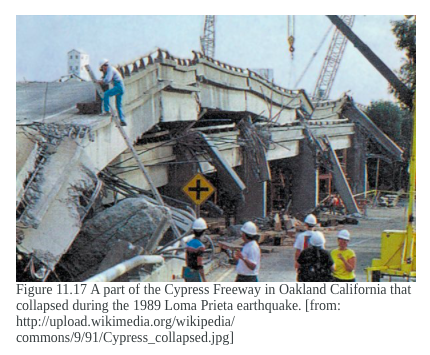 The geological foundations on which structures are built can have a
significant impact on earthquake shaking. When an earthquake happens,
the seismic waves produced have a wide range of frequencies. The energy
of the higher frequency waves tends to be absorbed by solid rock, while
the lower frequency waves (with periods slower than one second) pass
through the solid rock without being absorbed, but are eventually
absorbed and amplified by soft sediments. It is therefore very common to
see much worse earthquake damage in areas underlain by soft sediments
than in areas of solid rock. A good example of this is in the Oakland
area near San Francisco, where parts of a two-layer highway built on
soft sediments collapsed during the 1989 Loma Prieta earthquake (Figure
11.17 to the right).
The geological foundations on which structures are built can have a
significant impact on earthquake shaking. When an earthquake happens,
the seismic waves produced have a wide range of frequencies. The energy
of the higher frequency waves tends to be absorbed by solid rock, while
the lower frequency waves (with periods slower than one second) pass
through the solid rock without being absorbed, but are eventually
absorbed and amplified by soft sediments. It is therefore very common to
see much worse earthquake damage in areas underlain by soft sediments
than in areas of solid rock. A good example of this is in the Oakland
area near San Francisco, where parts of a two-layer highway built on
soft sediments collapsed during the 1989 Loma Prieta earthquake (Figure
11.17 to the right).
Building damage is also greatest in areas of soft sediments, and multi-storey buildings tend to be more seriously damaged than smaller ones. Buildings can be designed to withstand most earthquakes, and this practice is increasingly applied in earthquake-prone regions. Turkey is one such region, and even though Turkey had a relatively strong building code in the 1990s, adherence to the code was poor, as builders did whatever they could to save costs, including using inappropriate materials in concrete and reducing the amount of steel reinforcing. The result was that there were over 17,000 deaths in the 1999 M7.6 Izmit earthquake (Figure 11.18). After two devastating earthquakes that year, Turkish authorities strengthened the building code further, but the new code has been applied only in a few regions, and enforcement of the code is still weak, as revealed by the amount of damage from a M7.1 earthquake in eastern Turkey in 2011.
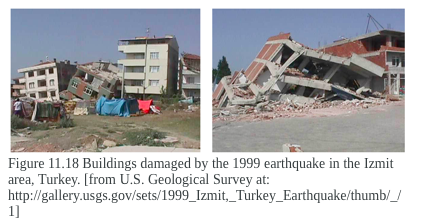 Fires are commonly associated with earthquakes because fuel pipelines
rupture and electrical lines are damaged when the ground shakes (Figure
11.19). Most of the damage in the great 1906 San Francisco earthquake
was caused by massive fires in the downtown area of the city (Figure
11.20). Some 25,000 buildings were destroyed by those fires, which were
fuelled by broken gas pipes. Fighting the fires was difficult because
water mains had also ruptured.
Fires are commonly associated with earthquakes because fuel pipelines
rupture and electrical lines are damaged when the ground shakes (Figure
11.19). Most of the damage in the great 1906 San Francisco earthquake
was caused by massive fires in the downtown area of the city (Figure
11.20). Some 25,000 buildings were destroyed by those fires, which were
fuelled by broken gas pipes. Fighting the fires was difficult because
water mains had also ruptured.
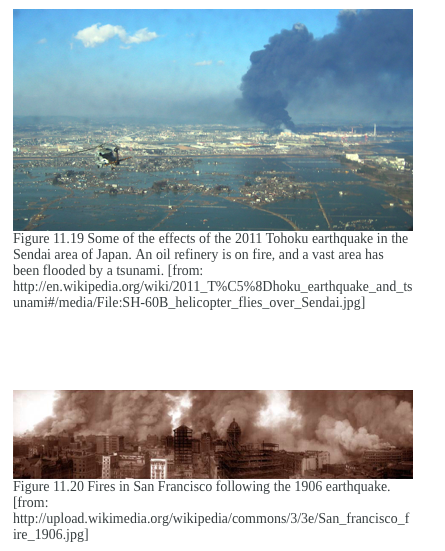
Earthquakes are important triggers for failures on slopes that are already weak. An example is the Las Colinas slide in the city of Santa Tecla, El Salvador, which was triggered by a M7.6 offshore earthquake in January 2001 (Figure 11.21).
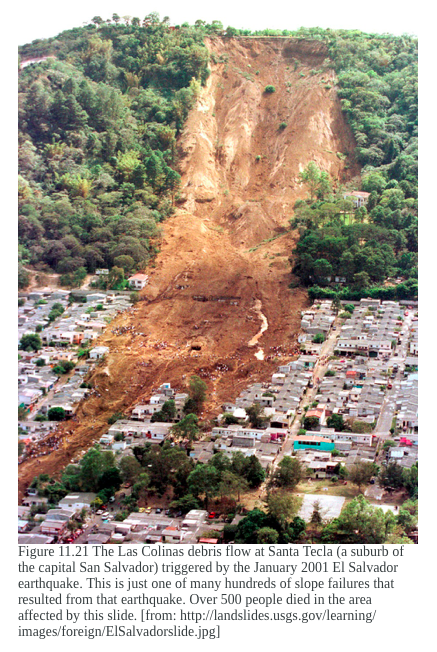
Ground shaking during an earthquake can be enough to weaken rock and unconsolidated materials to the point of failure, but in many cases the shaking also contributes to a process known as liquefaction, in which an otherwise solid body of sediment is transformed into a liquid mass that can flow. When water-saturated sediments are shaken, the grains become rearranged to the point where they are no longer supporting one another. Instead, the water between the grains is holding them apart and the material can flow. Liquefaction can lead to the collapse of buildings and other structures that might be otherwise undamaged. A good example is the collapse of apartment buildings during the 1964 Niigata earthquake (M7.6) in Japan (Figure 11.22). Liquefaction can also contribute to slope failures and to fountains of sandy mud (sand volcanoes) in areas where there is loose saturated sand beneath a layer of more cohesive clay.

Parts
of the Fraser River delta are prone to liquefaction-related damage
because the region is characterized by a 2 m to 3 m thick layer of
fluvial silt and clay over top of at least 10 m of water-saturated
fluvial sand (Figure 11.23). Under these conditions, it can be expected
that seismic shaking will be amplified and, the sandy sediments will
liquefy. This could lead to subsidence and tilting of buildings, and to
failure and sliding of the silt and clay layer. Current building-code
regulations in the Fraser delta area require that measures be taken to
strengthen the ground underneath multi-storey buildings prior to
construction.
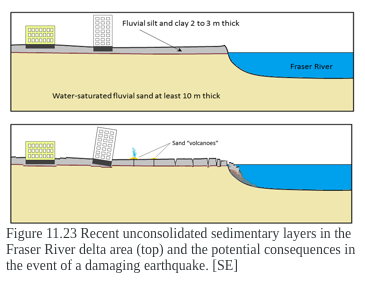
4. Environmental Impact - Volcanoes
On locations where tectonic plates diverge or converge, volcanoes can be found. A volcano consists of a deep magma chamber where magma accumulates, pipes that lead to surface vents, and the vents through which lava is emitted during a volcanic eruption. Volcanoes are often known to have a mountain-like shape (see picture).

Volcanoes that have not erupted for some time are dormant, and volcanoes that have not erupted even in the distant past are called extinct. Volcanic activity and volcanic eruption is usually triggered by alterations of tectonic plates, resulting in landslides or earthquakes.
There are different types of volcanic eruptions:
- Phreatic: explosion of steam, water, ash and rock as magma comes in contact with groundwater or surface water
- Rhyolite flow: high-silica lava (>68%)
- Basalt flow: low-silica lava (when the silica content is low, lava usually has a higher magnesium and iron content)
- Pyroclastic flow: fast-moving hot ash, gas and rock
- Lahar: mudflow of pyroclastic material into a river valley
- Carbon dioxide emission
Volcanic eruptions can be extremely damaging to the environment, particularly because of a number of toxic gases possibly present in pyroclastic material. It typically consists mainly of water vapour, but it also contains carbon dioxide and sulphur dioxide gas. Other gases typically found in volcanic ashes are hydrogen sulphide, hydrogen chloride, hydrogen fluoride, carbon monoxide, and volatile metal chlorides.
Carbon dioxide emitted from volcanoes adds to the natural greenhouse effect. Sulphur dioxides cause environmental problems, because they are converted to sulphuric acid in the stratosphere; the main cause of acid rain. Furthermore, sulphate aerosols are formed, which reflect solar radiation and absorb heat, thereby cooling the earth. Sulphate aerosols also take part in chemical reactions, forming ozone destructive material.
The effects of volcanoes on the environment also depend on climate patterns, the overall scale of the eruption and how much the gases spread. Another problem the environment is the ash that is released when a volcano erupts. Depending on the size of the eruption you could be looking at a volcanic winter.
An example of a volcanic eruption that caused substantial environmental damage is the Mount Pinatubo eruption in the Philippines. Watch the one minute video below to get a sense of how this eruption changed the landscape around it.
5. Human System Impact - Volcanoes
An Explosive Eruption
If there were an explosive
eruption in your area the effects of volcanoes could be devastating.
During an explosive eruption the volcano will spew lava, magma and
volcanic material which could travel several miles away from the
mountain. The explosiveness of the eruption could also cause pyroclastic
flows which would destroy anything within their path. The ash could
also cause severe damage to structures depending on the amount of it and
those who breathe it in would be at risk of choking on it.
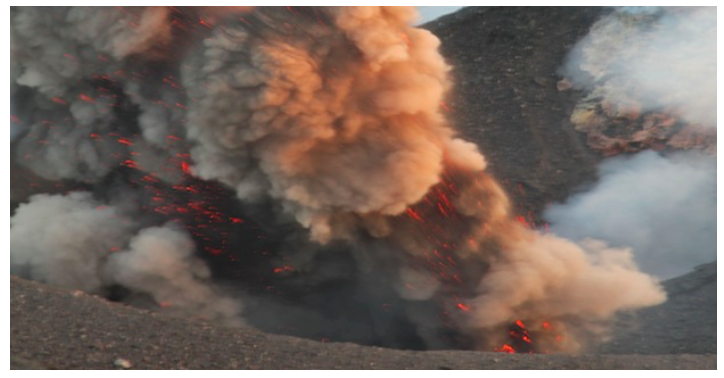
Problems To Aircraft
Aircraft are some of the things that will feel the effects of volcanoes more than others. That is because the ash spewed by a volcano can negatively affect the engines in an aircraft. To make matters worse the problem has not gotten better. Pilots who have flown through a volcanic eruption complain about the fact that they lose power and when they apply the throttle the engine will become even hotter. When that happens more ash is melted and that creates abrasive material which ends up in the engine.
Effects On Cities And Towns
The effects of volcanoes on cities and towns after an eruption could vary from no effects at all to a catastrophe of immeasurable magnitude. A lot of the effects that a city will feel depend on the size of the explosion or eruption and the atmospheric conditions. It has happened before that the conditions will take away the ash from the city. On the other hand, the same conditions could direct all the harmful effects of the lava, the ashes and volcanic material straight into the city which could cause thousands of deaths or injuries.
To look at the effects of volcanoes in towns and cities it is a good idea to look at recent eruptions. When Mauna Loa erupted in 1950 the lava headed towards the city of Hilo. Another eruption that took place in 1973 took place on Heimaey, Iceland and the entire town was buried under cinder and lava. In 1960 Kilauea erupted and it buried the town of Kapoho and in 1980 when Mount St. Helens erupted the ash fell on several towns in the states of Oregon and Washington. There are several examples of this type of volcano impacts on cities and towns.
6. Human System Impact - Tsunamis
In this lesson, we will look at the effects of tsunamis on human populations, yet you should keep in mind that many of these effects are also felt in the aftermath of hurricanes and floods. This is because of the effects of massive amounts of water, which not only destroy buildings, but pollute groundwater and allow for the spread of disease.
Effects of Tsunamis
The effects of a tsunami on a coastline can range from unnoticeable to devastating. The effects of a tsunami depend on the characteristics of the seismic event that generated the tsunami, the distance from its point of origin, its size and, at last, the configuration of the bathymetry (that is the depth of water in oceans) along the coast that the tsunami is approaching.
Small tsunamis, non-destructive and undetectable without specialized equipment, happen almost every day as a result of minor earthquakes and other events. They are very often too far away from land or they are too small to have any effect when they hit the shore. When a small tsunami comes to the shoreline it is often seen as a strong and fast-moving tide.
Tsunamis have long periods and can overcome obstacles such as gulfs, bays and islands. These tsunamis make landfall usually in the form of suddenly decreasing and then rapidly increasing water levels. Generally tsunamis arrive, not as giant breaking waves, but as a forceful rapid increase in water levels that results in violent flooding.
However, when tsunami waves become extremely large in height, they savagely attack coastlines, causing devastating property damage and loss of life. A small wave only 30 centimetres high in the deep ocean may grow into a monster wave 30m high as it sweeps over the shore. The effects can be further amplified where a bay, harbour, or lagoon funnels the waves as they move inland.
Watch the three minute video below, which shows the 2004 tsunami coming ashore in Malaysia. What you can see here is that the wave does not look threatening at first for the people on the beach.
Destruction
The amount of energy and water contained in a huge tsunami can cause extreme destruction when it strikes land.
The initial wave of a huge tsunami is extremely tall; however, most damage is not sustained by this wave. Most of the damage is caused by the huge mass of water behind the initial wave front, as the height of the sea keeps rising fast and floods powerfully into the coastal area. It is the power behind the waves, the endless rushing water that causes devastation and loss of life. When the giant breaking waves of a tsunami batter the shoreline, they can destroy everything in their path.
Destruction is caused by two mechanisms: the smashing force of a wall of water traveling at high speed, and the destructive power of a large volume of water draining off the land and carrying all with it, even if the wave did not look large.
Objects and buildings are destroyed by the sheer weight of the water, often reduced to skeletal foundations and exposed bedrock. Large objects such as ships and boulders can be carried several miles inland before the tsunami subsides.
Tsunami waves destroy boats, buildings, bridges, cars, trees, telephone lines, power lines - and just about anything else in their way. Once the tsunami waves have knocked down infrastructure on the shore they may continue to travel for several kilometres inland, sweeping away more trees, buildings, cars and other man made equipment. Small islands hit by a tsunami are left unrecognizable.
Especially along a high seismic area, known as the Ring of Fire, tsunamis may have dramatic consequences as they hit less developed countries.
The buildings infrastructure in these poorer nations are not well built and cannot withstand the impact of the tsunami. Whole areas and towns are a picture of destruction as the tsunami leaves at trail devastation and misery behind it.
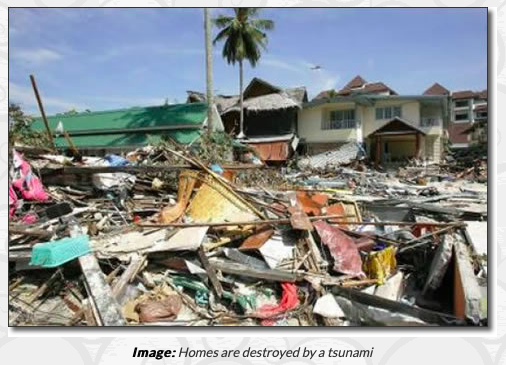
Death
One of the biggest and worst effects of a tsunami is the cost to human life because unfortunately escaping a tsunami is nearly impossible. Hundreds and thousands of people are killed by tsunamis. Since 1850 alone, tsunamis have been responsible for the loss of more than 430,000 lives. There is very little warning before a tsunamis hits land. As the water rushes toward land, it leaves very little time to map an escape plan.
People living in coastal regions, towns and villages have no time to escape. The violent force of the tsunami results in instant death, most commonly by drowning. Buildings collapsing, electrocution, and explosions from gas, damaged tanks and floating debris are another cause of death. The tsunami of December 2004 that struck South East Asia and East Africa killed over 31,000 people in Sri Lanka only, leaving 23,000 injured.
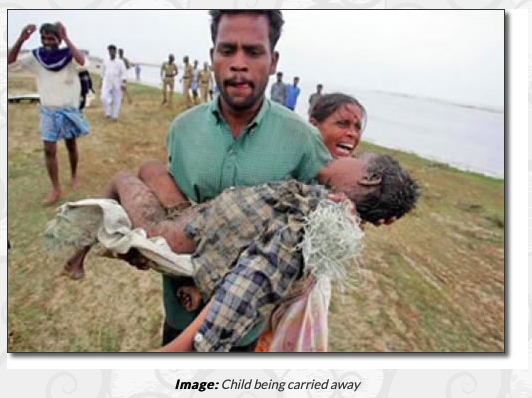
Disease
Tsunami waves and the receding water are very destructive to structures in the run-up zone. The areas close to the coast are flooded with sea water, damaging the infrastructure such as sewage and fresh water supplies for drinking.
Flooding and contamination of drinking water can cause disease to spread in the tsunami hit areas. Illnesses such as malaria arise when water is stagnant and contaminated. Under these conditions it is difficult for people to stay healthy and for diseases to be treated, so infections and illnesses can spread very quickly, causing more death.
Environmental impacts
Tsunamis not only destroy human life, but have a devastating effect on insects, animals, plants, and natural resources. A tsunami changes the landscape. It uproots trees and plants and destroys animal habitats such as nesting sites for birds. Land animals are killed by drowning and sea animals are killed by pollution if dangerous chemicals are washed away into the sea, thus poisoning the marine life.
The impact of a tsunami on the environment relates not only to the landscape and animal life, but also to the man-made aspects of the environment. Solid waste and disaster debris are the most critical environmental problem faced by a tsunami-hit country.
Recycling and disposal of this waste in an environmentally sensitive manner where possible (crushing concrete, bricks, etc. to produce aggregate for rebuilding and road reconstruction) are critical.
Combined with the issue of waste is that of hazardous materials and toxic substances that can be inadvertently mixed up with ordinary debris. These include asbestos, oil fuel, and other industrial raw materials and chemicals. Rapid clean-up of affected areas can result in inappropriate disposal methods, including air burning and open dumping, leading to secondary impacts on the environment.
Contamination of soil and water is the second key environmental impact of a tsunami. Salination of water bodies such as rivers, wells, inland lakes, and groundwater aquifers can occur in most cases. This also affects the soil fertility of agricultural lands, due to salination and debris contamination, which will affect yields in the medium and long term. Sewage, septic tanks and toilets are damaged contaminating the water supply.
Last but not least, there may be radiation resulting from damage to nuclear plants, as it happened in Japan in March 2011. Since radiation exists for a long time, it has the capacity to inflict damage upon anything exposed to it. Radiation is most dangerous to animals and humans causing destruction as molecules loose their electrons. The damage caused by radiation to the DNA structure determines birth defects, cancers even death.
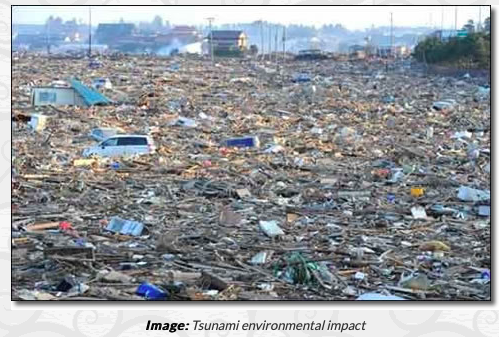
Cost
Massive costs hit communities and nations when a tsunami happens. Victims and survivors of the tsunami need immediate help from rescue teams.
Governments around the world may help with the cost of bringing aid to devastated areas. National institutions, the United Nations, other international organizations, community groups and NGOs , and a variety of other entities come together to provide different kinds of aid and services. There might also be appeals and donations from people who have seen pictures of the area in the media.
Reconstruction and clean up after a tsunami is a huge cost problem. Infrastructure must be replaced, unsafe buildings demolished and rubbish cleared. Loss of income in the local economy and future losses from the destruction of infrastructure will be a problem for some time to come.
The total financial cost of the tsunami could be millions or even billions of dollars of damage to coastal structures and habitats. It is difficult to put an exact figure on the monetary cost but the cost may represent an important share of a nation's GDP.